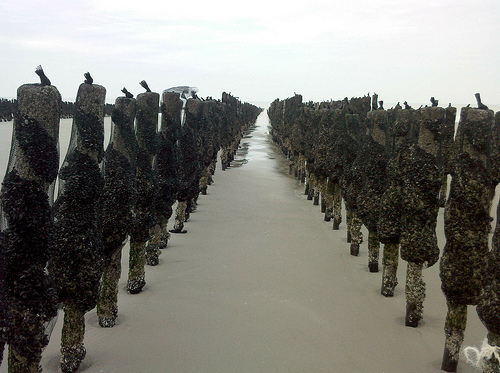Photo: Flickr/palimbiz
Have you ever seen “bouchot mussels” on a menu and wondered what exactly it means? Bouchot (French for “shellfish bed”) is a traditional aquaculture technique for mussels. It means that the mussel was grown on ropes strung from wooden poles in the sea. This results in grit and barnacle-free mussels with full meats and a cleaner flavor.
According to a 16th century text, bouchot mussels came about after a shipwrecked Scotsman, Patrick Walton, ran aground in the bay d’Aiguillon in 1235. He decided to stay in the region, and wanted to hunt seabirds for a living as he used to in Scotland. So, he drove wooden poles into the ground near the coast and stretched nets between them. Mussels began growing on the poles, and he realized that it was more profitable to raise shellfish than to hunt birds. Thus, bouchot mussel farming was invented. In 1954, the modern mussel aquaculture industry took off in the Bay of Mont Saint-Michel, and the Normandy region remains the leading producer of bouchot mussels.
In France, bouchot mussels are protected by AOP (protected origin) status, meaning they have to originate from the bay of Mont Saint-Michel to carry that name. However, the species is the blue mussel (Mytilus edulis), which is the most commonly farmed mussel species. So, for all practical purposes, a rope-grown blue mussel is essentially a bouchot mussel.
At Element Seafood, our large blue mussels are rope-cultured and come from Prince Edward Island. The northern location and colder waters means that they are available year-round, even during warm months when most mussel beds are spawning. With dense, full meats and a sweeter flavor than most mussels, they are perfect for steaming, sautéing, and baking. For more information about purchasing mussels, contact our sales department today!
